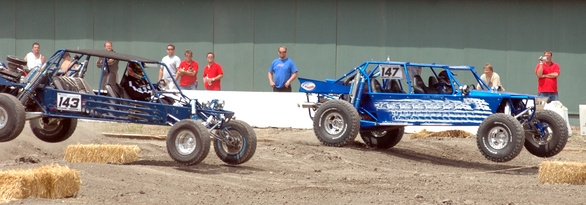
Although no single saying can sum up racing, the one that comes the closest is "Rubbing is racing." This old saying defines most Saturday night short track events to a tee. With all of that rubbing it is no wonder that race car bodies are built to be easily repaired. When a racer brings a new race car chassis into the shop to build and install a new body, he understands that despite his attention to detail, all of his hard work may ultimately end up as a pile of bent sheet metal on his shop floor.
Park the race car chassis on a flat level surface. This will allow you to hang the body at the correct measurements. Consult your rule book for your class body dimensions. A typical rule book will have measured drawings specifying body dimensions such as body width and height, as well as a designated roof and nose manufacturer.
Hang the roof. Place the prefab roof panel in place and mark the locations for the mounting brackets onto the top hoop of the roll cage with a pen. The brackets must be placed so that they sit on the top hoop of the roll cage. Place a drill bit into the drill motor. Drill holes in the positions you marked for the mounting brackets. Rivet the mounting brackets into position on the roof with the pop rivets and pop rivet gun. Place the roof back onto the chassis and attach with mounting bolts. Tighten with a wrench. The mounts will allow the roof panel to be adjusted to the recommended angle as stated in the rule book. Place an angle-finding gauge on the center of the roof panel and adjust the mounts until the desired angle is obtained.
Lay out the body panels. Beginning at the rear of the chassis and working your way forward, build and hang the body panels. Hold a flat piece of tin in place where you want to mount it. Mark any alterations, such as the wheel opening and bend locations, in pen on the tin. Cut away the unwanted material with the tin snips. Place the tin panel into the metal brake and bend any angle that is needed. Hang the trimmed and bent piece into position. Drill a hole through the tin and into the steel behind it. Insert a Cleco fastener into the hole to hold the tin in place. Drill another hole in the piece and insert another Cleco to hold the body in place. Continue this process along the entire side of the race car. Repeat this process on the opposite side of the race car. Remember to read the rule book for the specified body panel dimensions. Rules, such those requiring a wheel opening to have at least two inches of clearance around the tires, must be followed. Working from the rear to the front, make and hang all body panels in place and check the measurements, including ground clearance, against the rule book.
Rivet the body panels. When you are satisfied with the positioning of the body relative to the roof and are confident that the body conforms to the rules set forth by your division, replace the Cleco fasteners with pop rivets. Be sure to follow all sanctioning body rules for the proper mounting dimensions for your division concerning mounting points and minimum rivet spacing.
Set the prefab nose in place. Measure to ensure it is in the proper position as set forth by the rules pertaining to front fender and wheel openings. Drill through the nose piece and into the chassis. Pop rivet the nose in place. When setting the ground clearance for the nose, make sure to have the chassis weighted with the same amount of weight as the driver to assure your measurements will match at race time.
Create a hood. Place the blank hood piece into place and mark the opening for the air filter. It is often easiest to press the tin down onto the carburetor stud to make a mark on the underside of the hood. Measure from the mark on the underside of the hood to lay out a circle opening for the air breather; typically, a 14 1/4-inch opening will clear the 14-inch air filter assembly. Cut the opening by creating a starting hole with the drill and inserting the tin snips into the hole and cutting the opening. Set the hood into position and install hood lock pins by marking their locations on the chassis and drilling the hood to allow them to protrude through. Place the pins through the holes.
Have the body inspected. Make an appointment with a track official and have them check your body against the rule book. If the body conforms to the rules and is deemed legal, place an inspection sticker on the chassis or your track's designated location.